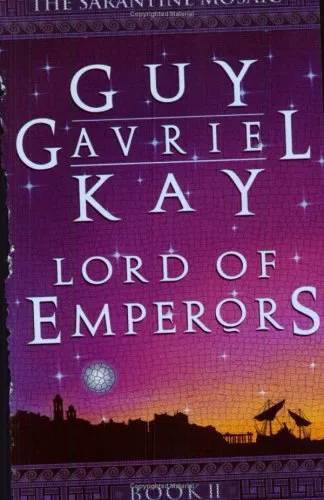Lord of Emperors
By (author): "Guy Gavriel Kay"
Publish Date:
February 11th 2000

ISBN0743450108
ISBN139780743450102
AsinLord of Emperors
Original titleLord of Emperors
SeriesThe Sarantine Mosaic #2
Art for Fantasy's Sake
Guy Gavriel Kay's Lord of Emperors triumphantly concludes the massive, two-volume historical fantasy collectively entitled the Sarantine Mosaic. Sailing to Sarantium, the opening volume, appeared last year and introduced us to Kay's dazzling fictional analogue of the early Byzantine Empire under Justinian I, who is here reimagined as Valerius II, the ambitious, infinitely subtle emperor of Sarantium. It also introduced us to a large cast of characters from every level of Sarantine society. Chief among these is Caius Crispus -- usually called Crispin -- a master mosaicist from the western province of Batiara. Crispin, who has lost his wife and two daughters to an outbreak of plague, is an acerbic, unhappy man with nothing to lose and nothing much to live for, until he is summoned to Sarantium to play a part in one of the emperor's grand designs. Valerius II has dedicated his reign to two particular goals. First, he plans to reunite the ancient, sundered Sarantine Empire by recapturing Batiara, which is currently ruled by the beleaguered young Queen Gisel. Second, he plans to dedicate a monumental new cathedral to the reigning deity of Sarantium, the sun god Jad. To Valerius, who has no children, these twin ambitions constitute his intended legacy to the future. This notion of legacies -- of monuments that endure beyond the span of the individual life -- is one of the novel's governing concerns and permeates the narrative on every level. Crispin's role in all this is to design and construct a vast mosaic that will cover the dome of the newly completed cathedral. This dome -- an architectural wonder patterned after the dome of Hagia Sophia in Constantinople -- appears to Crispin as "a gift," a huge canvas capable of supporting the most profound artistic visions. He conceives a mosaic commensurate with the canvas he is offered, which will both memorialize his own beloved dead and reflect his sense of the teeming, tumultuous, god-haunted world around him. Crispin sees this proposed mosaic as his own legacy, and all he wants is the opportunity to work on it, to stand on the scaffold -- above the affairs of emperors and men -- and pursue his vision. Of course, he cannot. The affairs of the world keep pulling him down from that scaffold and drawing him in. Lord of Emperors chronicles, in mesmerizing detail, the infinite complexity of that world, from the intrigues of Valerius's court to the more prosaic realities that govern the lives of the common people of Sarantium. The foremost of these is the obsessive factionalism that dominates Sarantine society, a factionalism whose focal point lies in the Hippodrome, site of the fanatically attended chariot races that Kay describes (both here and in Sailing to Sarantium) with such immediacy and power. Kay uses Crispin's story to open up a window on a critical period in Sarantine history, a period marked by political upheaval, religious controversy, and the complex interplay of hidden personal agendas. Many of the players whose stories intersect with Crispin's are the dominant figures of the empire, the central forces behind large, sometimes terrible events. Among them are Valerius himself, the former peasant who has gained the Sarantine throne through a formidable combination of cunning, ruthlessness, and foresight; Alixana, the dancer who became an empress and who is, in every significant respect, her husband's equal; Gisel, the besieged queen who will do whatever is necessary to protect Batiara from Sarantine invasion; Leontes, the military leader whose religious views will have an enormous impact on Crispin's planned mosaic; and Styliane Daleina, whose family was sacrificed to Valerius's ambitions and who is animated almost totally by her hatred of the emperor. At the same time, dozens of less exalted figures parade through these pages, among them legendary charioteers, dancers, and actresses, cooks, spies, and traitors, visiting physicians, children with second sight, scheming historians, soldiers, architects, artisans, and slaves. Kay moves his story gracefully along from character to character, viewpoint to viewpoint, place to place. During the course of its considerable length, the narrative encompasses not just Sarantium but the wider world beyond its borders. Within that wider world, foreign rulers devise schemes of their own, men and women offer their allegiance to very different gods, a "half world" filled with mysteries and magic occasionally asserts itself, and the Islamic threat that will eventually help to undermine Sarantium makes its first, tentative appearance. Kay has structured his hugely accomplished narrative exactly like a mosaic, artfully deploying hundreds of varied pieces, creating, in the process, a coherent, brightly colored world in which history and imagination work hand-in-hand. Seen in its entirety, the Sarantine Mosaic has the feel of a genuine magnum opus. It is an intelligent, ultimately moving narrative in which color, sweep, and spectacle are firmly grounded in an understanding of the universal need to leave something of value -- art, empires, children -- behind. Like Sailing to Sarantium, Lord of Emperors is imaginative fiction at its finest, an intimate epic that further consolidates Kay's position as the finest living practitioner of historical fantasy. ?Bill Sheehan